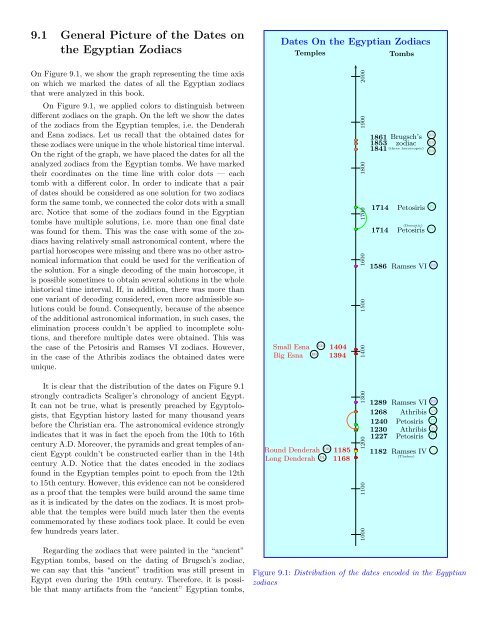mysteries of egyptian zodiacs - HiddenMysteries Information Central
mysteries of egyptian zodiacs - HiddenMysteries Information Central
mysteries of egyptian zodiacs - HiddenMysteries Information Central
You also want an ePaper? Increase the reach of your titles
YUMPU automatically turns print PDFs into web optimized ePapers that Google loves.
9.1 General Picture <strong>of</strong> the Dates on<br />
the Egyptian Zodiacs<br />
On Figure 9.1, we show the graph representing the time axis<br />
on which we marked the dates <strong>of</strong> all the Egyptian <strong>zodiacs</strong><br />
that were analyzed in this book.<br />
On Figure 9.1, we applied colors to distinguish between<br />
different <strong>zodiacs</strong> on the graph. On the left we show the dates<br />
<strong>of</strong> the <strong>zodiacs</strong> from the Egyptian temples, i.e. the Denderah<br />
and Esna <strong>zodiacs</strong>. Let us recall that the obtained dates for<br />
these <strong>zodiacs</strong> were unique in the whole historical time interval.<br />
On the right <strong>of</strong> the graph, we have placed the dates for all the<br />
analyzed <strong>zodiacs</strong> from the Egyptian tombs. We have marked<br />
their coordinates on the time line with color dots — each<br />
tomb with a different color. In order to indicate that a pair<br />
<strong>of</strong> dates should be considered as one solution for two <strong>zodiacs</strong><br />
form the same tomb, we connected the color dots with a small<br />
arc. Notice that some <strong>of</strong> the <strong>zodiacs</strong> found in the Egyptian<br />
tombs have multiple solutions, i.e. more than one final date<br />
was found for them. This was the case with some <strong>of</strong> the <strong>zodiacs</strong><br />
having relatively small astronomical content, where the<br />
partial horoscopes were missing and there was no other astronomical<br />
information that could be used for the verification <strong>of</strong><br />
the solution. For a single decoding <strong>of</strong> the main horoscope, it<br />
is possible sometimes to obtain several solutions in the whole<br />
historical time interval. If, in addition, there was more than<br />
one variant <strong>of</strong> decoding considered, even more admissible solutions<br />
could be found. Consequently, because <strong>of</strong> the absence<br />
<strong>of</strong> the additional astronomical information, in such cases, the<br />
elimination process couldn’t be applied to incomplete solutions,<br />
and therefore multiple dates were obtained. This was<br />
the case <strong>of</strong> the Petosiris and Ramses VI <strong>zodiacs</strong>. However,<br />
in the case <strong>of</strong> the Athribis <strong>zodiacs</strong> the obtained dates were<br />
unique.<br />
It is clear that the distribution <strong>of</strong> the dates on Figure 9.1<br />
strongly contradicts Scaliger’s chronology <strong>of</strong> ancient Egypt.<br />
It can not be true, what is presently preached by Egyptologists,<br />
that Egyptian history lasted for many thousand years<br />
before the Christian era. The astronomical evidence strongly<br />
indicates that it was in fact the epoch from the 10th to 16th<br />
century A.D. Moreover, the pyramids and great temples <strong>of</strong> ancient<br />
Egypt couldn’t be constructed earlier than in the 14th<br />
century A.D. Notice that the dates encoded in the <strong>zodiacs</strong><br />
found in the Egyptian temples point to epoch from the 12th<br />
to 15th century. However, this evidence can not be considered<br />
as a pro<strong>of</strong> that the temples were build around the same time<br />
as it is indicated by the dates on the <strong>zodiacs</strong>. It is most probable<br />
that the temples were build much later then the events<br />
commemorated by these <strong>zodiacs</strong> took place. It could be even<br />
few hundreds years later.<br />
Regarding the <strong>zodiacs</strong> that were painted in the “ancient”<br />
Egyptian tombs, based on the dating <strong>of</strong> Brugsch’s zodiac,<br />
we can say that this “ancient” tradition was still present in<br />
Egypt even during the 19th century. Therefore, it is possible<br />
that many artifacts from the “ancient” Egyptian tombs,<br />
Dates On the Egyptian Zodiacs<br />
Temples Tombs<br />
Small Esna EM 1404<br />
Big Esna EB 1394<br />
<br />
Round Denderah <br />
DR <br />
1185<br />
Long Denderah DL 1168<br />
<br />
<br />
<br />
<br />
<br />
<br />
<br />
<br />
<br />
<br />
1000 1100 1200 1300 1400 1500 1600 1700 1800 1900 2000<br />
1861<br />
1853<br />
1841<br />
Brugsch’s<br />
zodiac<br />
(three horoscopes)<br />
BR<br />
1<br />
BR<br />
3<br />
BR<br />
2<br />
1714 Petosiris P2<br />
1714 Petosiris P1<br />
(Demotic)<br />
1586 Ramses VI RS<br />
1289 Ramses VI RS<br />
1268 Athribis AN<br />
1230 Athribis AV<br />
1240 Petosiris P2<br />
1227 P1<br />
Petosiris<br />
1182 Ramses IV OU<br />
(Thebes)<br />
Figure 9.1: Distribution <strong>of</strong> the dates encoded in the Egyptian<br />
<strong>zodiacs</strong>



